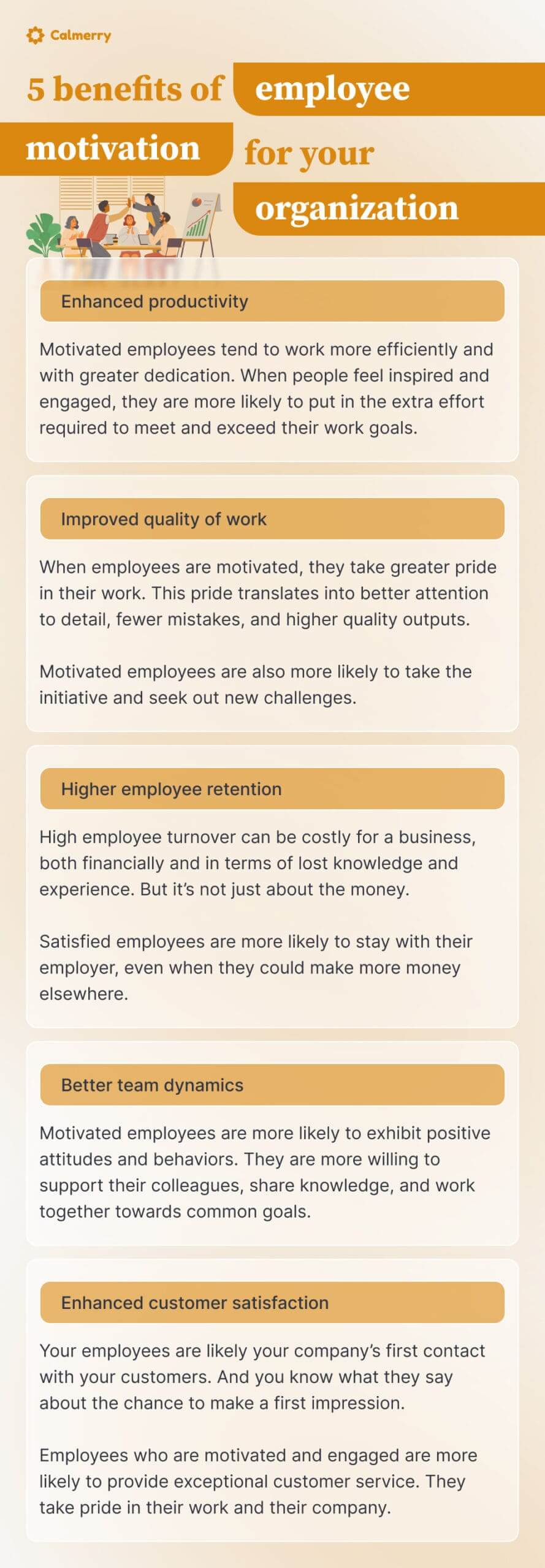How to Motivate Employees: 10 Strategies to Energize Your Team

In this article
In today’s fast-paced and highly competitive business environment, a stable and productive workforce is more important than ever to the success of any organization.
One key factor that significantly influences performance is motivation.
Motivated employees are more productive, creative, and committed to their work, contributing positively to the organization’s overall goals. At the same time, it’s important that the organization be similarly committed to their employees.
One of the biggest challenges that faces any business is just how to motivate employees. After all, they work for the company (aka “they have a job”) and get paid. Shouldn’t that be motivation enough?
Actually, motivation is way more complicated than that. Motivation is multifaceted and is not a one-size-fits-all. Research tells us that what motivates people varies from person to person and has a deep emotional component that a paycheck might not tap into.
Understanding work-related motivation and adopting effective strategies for motivation can help you create a solid, well-performing workforce.
The importance of employee motivation
Whether it’s intrinsic motivation or external motivation, the fact is, every employer wants a motivated team of employees. A motivated workforce is at the heart of a successful organization and brings energy to the workplace.
Enhanced productivity
Motivated employees tend to work more efficiently and with greater dedication. When people feel inspired and engaged, they are more likely to put in the extra effort required to meet and exceed their work goals.
This increased productivity directly impacts the company’s bottom line, as tasks are completed more quickly and to a higher standard.
Improved quality of work
When employees are motivated, they take greater pride in their work. This pride translates into better attention to detail, fewer mistakes, and higher quality outputs.
Motivated employees are also more likely to take the initiative, seek out new challenges, and develop innovative solutions to problems, enhancing the overall quality of work within the organization.
Higher employee retention
High employee turnover can be costly for a business, both financially and in terms of lost knowledge and experience. But it’s not just about the money.
The good news is that employee satisfaction and retention seem to be on the rise overall, and the organizational environment seems to be front and center in those trends.
As previously mentioned, motivation is a key contributor to employee satisfaction.
Satisfied employees are more likely to stay with their employer, even when they could make more money elsewhere.
By fostering a motivating and stimulating work environment, companies can:
- Improve employee retention rates
- Save on recruitment and training costs
- Retain employees with important institutional knowledge
- Maintain a stable and experienced workforce
Better team dynamics
Motivated employees are more likely to exhibit positive attitudes and behaviors, contributing to a more cohesive and collaborative work environment and a sense of belonging.
They are more willing to support their colleagues, share knowledge, and work together towards common goals.
Enhanced customer satisfaction
Your employees are likely your company’s first contact with your customers. And you know what they say about the chance to make a first impression.
Employees who are motivated and engaged are more likely to provide exceptional customer service. They take pride in their work and their company.
Their positive attitude and dedication can enhance customer experiences, leading to higher customer satisfaction and loyalty. Satisfied customers are more likely to return and recommend the company to others, driving business growth and success.
Adopting strategies to support and motivate employees doesn’t have to be complicated or break the budget.
In fact, most proven motivational practices are more about making connections than they are about big, flashy motivational programs or simply writing a bigger check. It’s all about the employee’s experience.
– Dr. Dawn Ferrara, PsyD, Licensed Professional Counselor (LPC), and mental health writer

10 Ways to motivate your team
There’s an old saying that goes something like this: people may not remember what you said or did, but they will always remember how you made them feel.
Now, this might be a little confusing because, after all, we’re talking about business, not a counseling session. However, when it comes to building a supportive, inclusive, and stimulating work environment, it is very much about how the practices in place are experienced by the employee.
Do they create a sense of being a valued member of the team, or are they simply practices that you put on paper and pull out when there’s a problem?
This might sound like a lot of “warm fuzzies,” but the fact is, employees are more than just a part of a work team. Your employees are people with feelings, needs, and goals. They are moms and dads, sisters and brothers, friends, and part of a larger community – a community in which your business operates.
Creating a work environment that respects and empowers employees translates into a more motivated, satisfied, and productive team.
– Dr. Dawn Ferrara, PsyD, Licensed Professional Counselor (LPC), and mental health writer
While there are any number of ways to motivate employees, here are some of the tried-and-true strategies that you can implement:
1. Provide clear goals and expectations
There’s nothing more frustrating than trying to read someone’s mind about what they want. It comes with a 50/50 chance of being wrong. When it’s your team that you’ve failed, motivation goes right out the window.
One of the most effective motivational strategies you can adopt is to provide clear and achievable goals and expectations for meeting them. Your employees need to clearly understand what is expected of them and how their efforts contribute to the overall success of the team.
When they can envision the path to success, they are more likely to feel empowered to act with intention. SMART goals are a great tool for breaking goals into small, measurable steps.
Just a reminder, in case it’s been a minute, SMART goals are:
- S – Specific
- M – Measurable
- A – Attainable
- R – Relevant
- T – Time-limited
2. Offer opportunities for professional development
Many of your employees probably have professional goals in mind. Seeing opportunities for professional growth and advancement within the company can be a powerful source of motivation.
Regarding your company’s current approach to professional development:
- Is professional development encouraged or discussed routinely?
- Do your employees have a way to share their professional aspirations with their managers?
- Does the company have resources that support professional growth and advancement? If so, how are your employees informed about such resources and how to access them?
It’s a best practice to retain employees who are committed to investing time into their professional growth. Their institutional knowledge and commitment are invaluable.
Providing access to training programs, workshops, and career development resources can help your employees enhance their skills and advance their careers.
Encouraging a culture of continuous learning also fosters innovation and adaptability, key factors for success in times of stability and in times of workplace crisis. The pandemic taught us all many lessons in the value of adaptability and resilience in the workplace.
3. Recognize and reward achievements
Recognition and rewards are powerful motivators. Being recognized for a job well done sends a powerful message to an employee that their presence on the team and their contributions are valued and that they matter.
Acknowledging their efforts and accomplishments can boost employee morale and encourage continued excellence.
Recognition can take various forms:
- Employee of the Month awards
- Performance bonuses
- Public acknowledgment in meetings or company communications
- Team recognition events (e.g., company picnics, catered lunch days, etc.)
- Celebrating a significant achievement (e.g., achieving a certification or attaining a team goal)
- Praise – recognize the little victories, too. For some employees, it’s the little things that add up to big gains. Sometimes, a “great job” is all they need on a really hard day.
Never underestimate the power of in-the-moment words of praise.
Research has found that unexpected rewards like verbal praise can significantly increase intrinsic motivation. Why? The short answer is that it makes us feel good. And when things make us feel good, we want to keep doing them.
4. Foster a positive work environment
Our environment exerts a powerful influence over how we navigate that space. A positive work environment is essential for employee motivation.
This includes creating a supportive and inclusive culture, promoting work-life balance, and ensuring a safe and comfortable workplace.
Research reveals that people want to work in a space where they feel physically and emotionally safe and respected. Encouraging open communication, providing regular feedback, and addressing any issues promptly can also contribute to a positive work environment.
5. Empower employees with autonomy
Giving employees a sense of autonomy and control over their work can significantly enhance motivation. When employees feel trusted and empowered to make decisions, they are more likely to take ownership of their tasks and perform at their best.
One of the potential stumbling blocks for employees is not knowing when or if they have the latitude to make autonomous decisions. The team may be missing out on some great ideas because it may not feel OK to speak up or take on the task.
As a manager, you can avoid this potential pitfall by staying in the loop and having routine conversations about the work.
Creating opportunities for employees to contribute ideas and take on leadership roles can foster a sense of empowerment and help them recognize that their ideas and input are welcome and valuable.
– Dr. Dawn Ferrara, PsyD, Licensed Professional Counselor (LPC), and mental health writer
6. Encourage collaboration and teamwork
You know that saying “teamwork makes the dream work”? Teamwork is critical to your company’s success, even though processes can sometimes feel quite disconnected.
The fact is every person, and every unit, are essential to making the dream work. Promoting a collaborative work environment can enhance motivation by making employees feel part of a cohesive team.
When someone feels part of the team they are motivated to bring their A-game because the team is depending on them.
Teams usually don’t just gel. They are built through shared causes, experiences, or goals. As a manager, you can foster teamwork through:
- Group projects and encouraging team member input into tasks and goals
- Team-building activities
- Encouraging collaboration and using tools that encourage collaboration between team members
- Celebrating team successes
7. Offer competitive compensation and benefits
Fair and competitive compensation is a fundamental aspect of employee motivation. Employees need to feel that they are fairly compensated for their efforts and that their financial needs are being met.
In addition to competitive salaries, companies can offer benefits such as health insurance that includes employee mental health benefits, retirement plans, and paid time off.
Additional perks, such as flexible working arrangements, wellness programs, and employee discounts, can also enhance motivation.
8. Provide regular feedback
Regular feedback is essential for employee growth and motivation. In addition to recognition for a job well done, employees also need constructive feedback on their overall performance. Such feedback helps them to recognize their strengths and areas for improvement, guiding their professional development and performance.
Regular feedback can be most effective when a company establishes a culture of constructive, continuous feedback, where employees receive regular input from their managers and peers.
This practice normalizes feedback and presents it as a constructive opportunity for growth rather than a negative experience.
Regular feedback can also provide employees with opportunities for setting development goals and receiving mentorship that supports their professional growth.
9. Encourage work-life balance
Work-life balance has come to the forefront in employee expectations and is crucial for maintaining employee motivation and well-being. In fact, a recent survey found that about 86% of employers view employee mental health as top concern for their company.
It’s important to remember the human side of being an employee. They may be experiencing stressors you’re not aware of, whether at home or at work, which can have a profound impact on their performance and motivation.
Companies can support work-life balance by:
- Offering flexible working hours
- Remote work options
- Flexible leave policies
- Encourage employees to take their daily breaks, lunch breaks, and vacations
- Encourage them to disconnect from work after hours
- Encourage them to prioritize their physical and emotional well-being
- Educate employees about available health/mental health benefits and resources
- Normalize talking about mental health and the importance of caring for themselves
10. Lead by example
As someone in a leadership position, you set the tone and example for your employees in the ways you interact with them. They look to you for guidance and support and will take their cues from you as to what’s expected and appropriate.
They need to know that you are steady, reliable, and actively managing any situation that arises.
Leading by example means modeling the same behaviors and attitudes that you expect from your employees, and being the calm in the storm when problems arise.
– Dr. Dawn Ferrara, PsyD, Licensed Professional Counselor (LPC), and mental health writer
Some examples include:
- Being approachable and visible
- Communicating openly and often
- Showing genuine interest in and appreciation for employees
- Showing respect for every person
- Following through on commitments. Your word is your bond.
Leading by example fosters high levels of engagement and trust, and is a powerful way to foster a motivated and committed team.
Support for leadership from Calmerry
Investing in employee motivation not only enhances individual performance but also drives overall organizational success.
As the business landscape continues to evolve, companies that prioritize and nurture employee motivation will be better positioned to achieve their goals and maintain a competitive edge.
Partnering with resources that can support your employees’ well-being can be an effective addition to your company’s commitment to employee wellness. And, it doesn’t have to be complicated.
Calmerry offers a cost-effective solution to your company’s employee wellness needs. With packages tailored to meet your company’s needs, you can be assured your employees are receiving quality mental health services.
One of the biggest challenges people have when seeking help is knowing where to go and how to make time. For employees, there’s always the worry about taking time off for personal needs.
Calmerry’s online program offers mental health services that can be accessed where and when it best meets your employees’ needs and removes the inconvenience of having to take time off for appointments. Most people can begin receiving services within one business day.
When your employees need mental health support, Calmerry is ready to help.
Let's connect
Book a 30-min demo call with us to learn more about our B2B offering and how Calmerry can help take the pressure off your team through flexible, customizable, and holistic therapy.
- See a live demonstration of how platform works
- Have an overview of our flexible payment models
- Get a tailored offer based on your company needs and number of employees
online therapy
live video session



